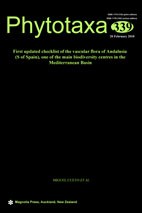Abstract
Andalusia, together with Morocco, is considered part of one of the two main biodiversity centres existing in the Mediterranean Basin; the other one is in the east and includes part of Turkey and Greece. The Andalusian flora has a fundamental role in this recognition, having been studied since the 1st century A.D. Despite Andalusia having been visited by a myriad of Iberian and foreign botanists, there is still no synthetic work on this subject. In this contribution, we present the first checklist of the Andalusian vascular flora, listing 4437 taxa distributed in 171 families, 1107 genera, 4091 species, and 346 subspecies, of which 3958 are native and 479 alien. Therophytes predominate (1516, 34.2%), followed by hemicryptophytes (1219, 27.5%) and chamaephytes (628, 14.1%). In addition, 462 (10.4%) are endemic or sub-endemic to the territory, and 595 (13.4%) are subject to some degree of threat (135 critically endangered, 137 endangered, and 323 vulnerable).

